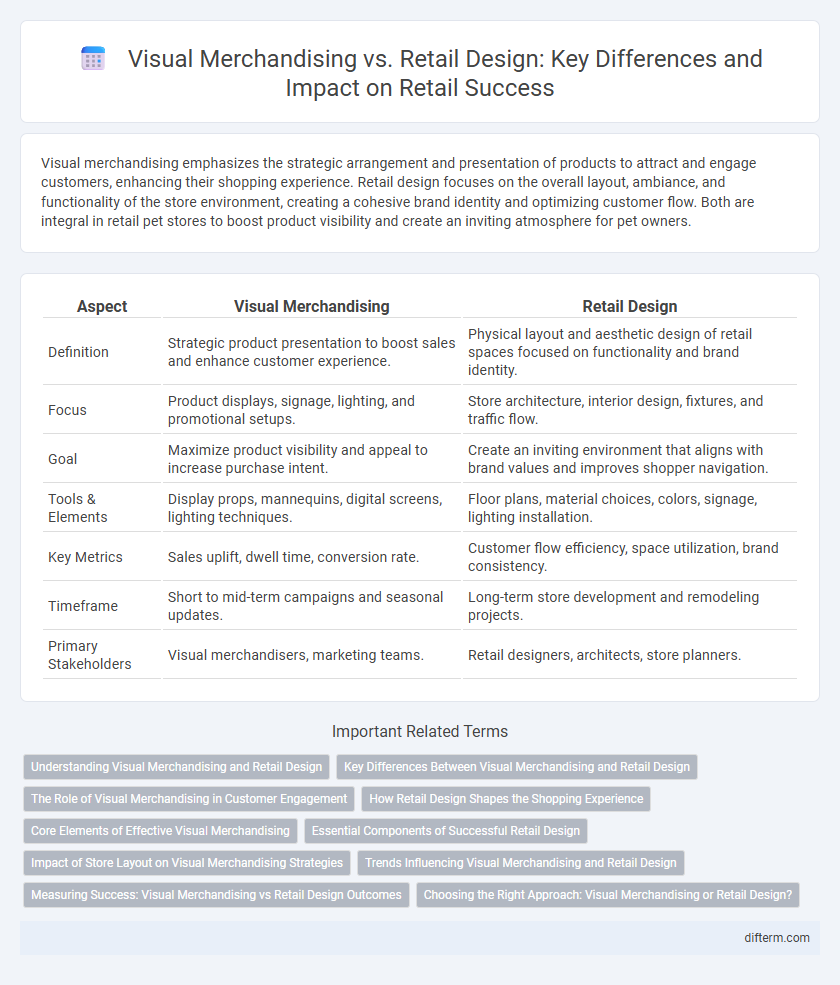Visual merchandising emphasizes the strategic arrangement and presentation of products to attract and engage customers, enhancing their shopping experience. Retail design focuses on the overall layout, ambiance, and functionality of the store environment, creating a cohesive brand identity and optimizing customer flow. Both are integral in retail pet stores to boost product visibility and create an inviting atmosphere for pet owners.
Table of Comparison
| Aspect | Visual Merchandising | Retail Design |
|---|---|---|
| Definition | Strategic product presentation to boost sales and enhance customer experience. | Physical layout and aesthetic design of retail spaces focused on functionality and brand identity. |
| Focus | Product displays, signage, lighting, and promotional setups. | Store architecture, interior design, fixtures, and traffic flow. |
| Goal | Maximize product visibility and appeal to increase purchase intent. | Create an inviting environment that aligns with brand values and improves shopper navigation. |
| Tools & Elements | Display props, mannequins, digital screens, lighting techniques. | Floor plans, material choices, colors, signage, lighting installation. |
| Key Metrics | Sales uplift, dwell time, conversion rate. | Customer flow efficiency, space utilization, brand consistency. |
| Timeframe | Short to mid-term campaigns and seasonal updates. | Long-term store development and remodeling projects. |
| Primary Stakeholders | Visual merchandisers, marketing teams. | Retail designers, architects, store planners. |
Understanding Visual Merchandising and Retail Design
Visual merchandising focuses on creating attractive product displays and layouts to engage customers and boost sales within a retail space. Retail design encompasses the broader architectural and interior planning of stores, including lighting, signage, and customer flow to enhance the overall shopping experience. Understanding the distinction between visual merchandising and retail design is crucial for optimizing both aesthetic appeal and functional store performance.
Key Differences Between Visual Merchandising and Retail Design
Visual merchandising focuses on product presentation to enhance customer engagement and drive sales through strategic display techniques, while retail design encompasses the overall layout and architectural elements of the store to optimize flow and brand experience. Key differences include visual merchandising's emphasis on temporary, seasonal setups and promotional displays, contrasting with retail design's permanent fixtures and spatial planning. Both disciplines integrate to create cohesive shopping environments but prioritize different aspects of the retail space.
The Role of Visual Merchandising in Customer Engagement
Visual merchandising plays a crucial role in customer engagement by strategically showcasing products to attract attention and influence purchasing decisions. Effective visual displays create immersive shopping experiences that enhance brand perception and encourage longer store visits. Integrating lighting, color schemes, and spatial arrangements in visual merchandising boosts customer interaction and drives sales in retail environments.
How Retail Design Shapes the Shopping Experience
Retail design shapes the shopping experience by strategically arranging space, lighting, and fixtures to create an inviting and intuitive environment that guides customer flow and enhances product visibility. Effective retail design integrates branding elements and sensory cues to influence consumer behavior, encouraging longer store visits and higher purchase rates. This holistic approach contrasts with visual merchandising, which focuses primarily on product presentation and display aesthetics within the established retail design framework.
Core Elements of Effective Visual Merchandising
Effective visual merchandising hinges on core elements such as strategic product placement, balanced color schemes, and captivating lighting techniques that enhance shopper engagement. Incorporating focal points and clear signage guides customer flow and highlights key merchandise, boosting sales potential. Texture and space optimization create an inviting environment that encourages browsing and influences purchasing behavior.
Essential Components of Successful Retail Design
Successful retail design hinges on creating an engaging customer experience by strategically integrating lighting, space planning, and signage to enhance brand identity and product visibility. Visual merchandising plays a critical role by arranging products in appealing displays that drive shopper interaction and increase sales conversion rates. Effective collaboration between retail designers and visual merchandisers ensures the cohesive execution of these elements, optimizing store layout and atmospherics for maximum consumer engagement.
Impact of Store Layout on Visual Merchandising Strategies
Store layout directly influences visual merchandising strategies by shaping customer flow and product visibility, thereby optimizing engagement and sales potential. Strategic placement of displays within aisles and focal points enhances product appeal, driving purchase decisions through targeted visual cues. Effective integration of retail design elements such as lighting, shelving, and signage amplifies the impact of visual merchandising, creating an immersive shopping experience that maximizes conversion rates.
Trends Influencing Visual Merchandising and Retail Design
Current trends in visual merchandising and retail design emphasize the integration of immersive technology such as augmented reality to enhance customer engagement and personalize shopping experiences. Sustainable materials and eco-friendly displays are becoming standard as consumers increasingly prioritize environmental responsibility in retail environments. Flexible layouts promoting social distancing and touchless interactions are also shaping the future of store design to meet evolving health and safety standards.
Measuring Success: Visual Merchandising vs Retail Design Outcomes
Measuring success in visual merchandising centers on increased product visibility, customer engagement, and conversion rates, often evaluated through sales uplift and dwell time analytics. Retail design success is assessed by overall store layout efficiency, customer flow optimization, and brand experience consistency, typically measured via foot traffic patterns and average transaction value. Both disciplines contribute distinct yet complementary metrics that together drive comprehensive retail performance analysis.
Choosing the Right Approach: Visual Merchandising or Retail Design?
Choosing the right approach between visual merchandising and retail design depends on whether the focus is enhancing product presentation or creating an immersive store environment. Visual merchandising prioritizes product placement, lighting, and display techniques to boost sales and customer engagement. Retail design encompasses store layout, materials, and architectural elements to build a cohesive brand experience and optimize shopper flow.
Visual Merchandising vs Retail Design Infographic

 difterm.com
difterm.com